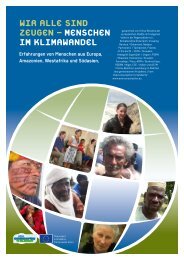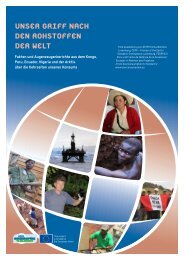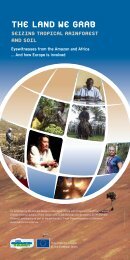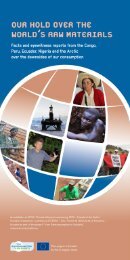WE ARE ALL WITNESSES - PEOPLE IN A CHANGING CLIMATE
The 24 panels of the "We are all witnesses - People in a Changing Climate" exhibition illustrate how climate change is already taking place in 16 countries in four countries.
The 24 panels of the "We are all witnesses - People in a Changing Climate" exhibition illustrate how climate change is already taking place in 16 countries in four countries.
You also want an ePaper? Increase the reach of your titles
YUMPU automatically turns print PDFs into web optimized ePapers that Google loves.
Amazon:<br />
Droughts<br />
The Amazon is home to<br />
the largest rainforest<br />
in the world, covering<br />
roughly 6 million<br />
square kilometres.<br />
Around a third of<br />
all animal and plant<br />
species on Earth<br />
live here, as well<br />
as over 1.5 million<br />
indigenous people<br />
from approximately<br />
400 different nations.<br />
© Gustavo Tosello / ISA<br />
The dry port of São<br />
Gabriel da Cachoeira<br />
on the Rio Negro,<br />
February 2007<br />
View from the Alto<br />
da Serra de Tunuí.<br />
Waterfalls on the<br />
Isana River in northern<br />
Brazil<br />
Diego Escobar<br />
COICA<br />
© Nicole Romijn Fotografie<br />
© Camila Sobral Barra / ISA<br />
Diego Escobar, Coordinator of<br />
Territories, Environment and Natural<br />
Resources at COICA (Coordinator<br />
of Indigenous Organizations of the<br />
Amazon Basin) and Vice-Chair of<br />
the Climate Alliance:<br />
In addition to exceptional rainfall<br />
in some regions there were more<br />
“droughts of the century” in the<br />
Amazon, such as in 2005 and 2010.<br />
All the rivers dried up completely,<br />
so that the people living in those<br />
regions could not leave their<br />
communities and had to be supplied<br />
by the military. Millions of trees<br />
died off; forest fires increased.<br />
In addition to the exploitation of<br />
natural resources, such as illegal<br />
logging, the expansion of agriculture<br />
and large-scale infrastructure<br />
projects, climate change is a new<br />
additional danger for us: We, the<br />
indigenous peoples of the Amazon,<br />
protect the rain forest, which has<br />
always been the foundation of our<br />
lives.<br />
SCIENTIFIC BACKGROUND<br />
Observations in the Amazon by satellite and on the ground have shown<br />
more dying trees and forest fires during the recent drought. About 70 million<br />
hectares of forest in the western Amazon suffered during the dry season in<br />
2005 from severe water shortage and a concomitant reduction of the canopy<br />
and loss of moisture that lasted until the next drought period in 2010.The<br />
result suggests that a 5 - 10 year cycle of drought leads to a permanent<br />
change in the forest roof.<br />
Current rates of deforestation and forest degradation mean the Amazon is<br />
approaching a tipping point, in which rain forests become seasonal forests or<br />
even savannahs and convert from carbon sinks into carbon sources.<br />
Ecuador<br />
Colombia<br />
Peru<br />
Chile<br />
Venezuela<br />
Guyana<br />
Suriname French Guyana<br />
AMAZON<br />
Bolivia<br />
Paraguay<br />
Brazil<br />
© Copyright: Klima-Bündnis<br />
Rainforest biomass is a huge<br />
carbon sink: an average<br />
hectare of rainforest<br />
binds approximately 5 –<br />
20 tonnes of carbon<br />
dioxide annually and stores<br />
around 250 tonnes of<br />
carbon permanently in the<br />
biomass. Where indigenous<br />
people have secured their<br />
land rights, the rain forest<br />
is the best preserved.<br />
Consequently, they make an<br />
outstanding contribution to<br />
environmental protection.<br />
Further information at: www.overconsumption.eu<br />
Argentina









